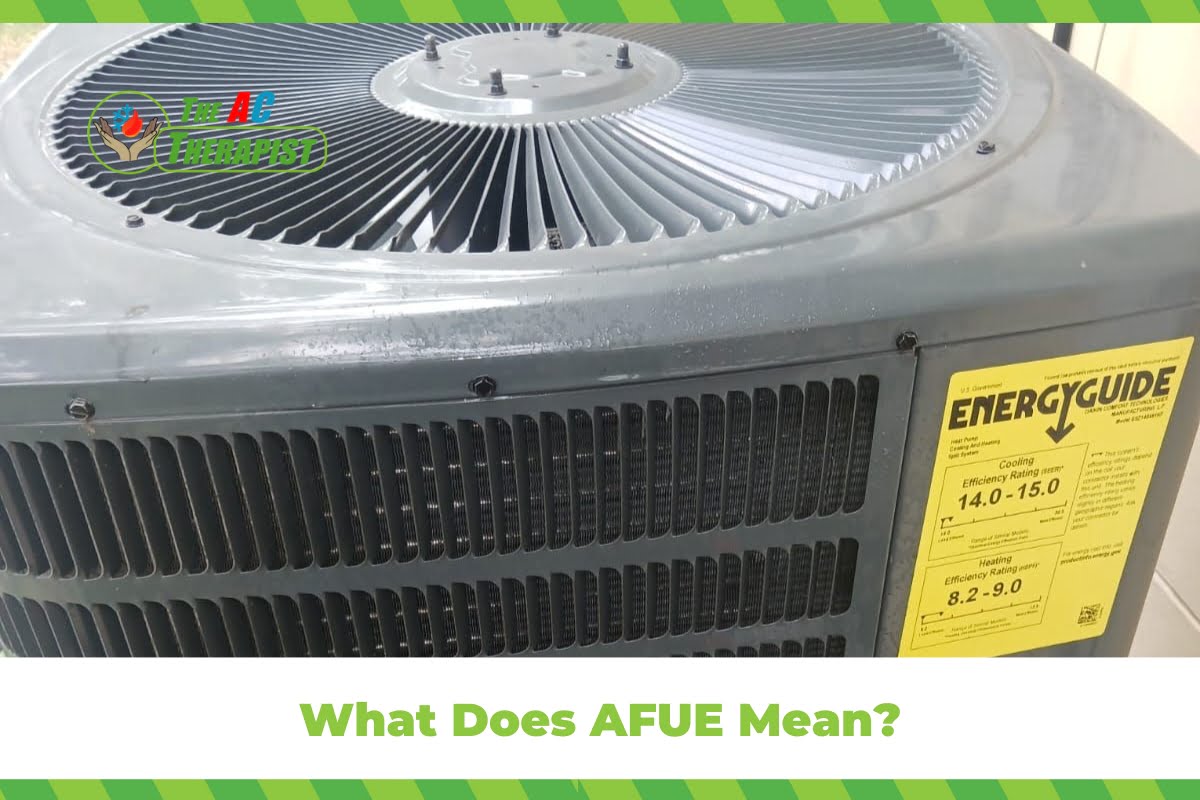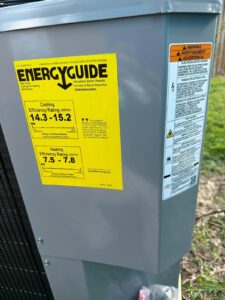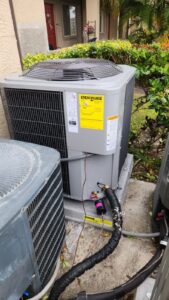What Does AFUE Mean?
When it comes to heating your home, understanding the efficiency of your HVAC system is crucial. This is where the term AFUE – Annual Fuel Utilization Efficiency – becomes significant. In this comprehensive guide, we’ll explore what AFUE means in the context of your HVAC system, why it’s important, and how it can impact your energy usage and costs.
Understanding AFUE: The Basics
Annual Fuel Utilization Efficiency is a measure used to gauge the efficiency of a furnace or boiler in converting the energy in its fuel to heat for a typical year. It is expressed as a percentage, indicating how much fuel is effectively converted into usable heat. For example, a furnace with an AFUE rating of 80% means that 80% of the fuel consumed is used for heating, while the remaining 20% escapes, often through the chimney or venting system.
Why AFUE Matters: The Key to Efficient Home Heating
When it comes to home heating, efficiency is king. Not only does an efficient heating system keep you comfortable, but it also controls energy costs and reduces environmental impact. This is where AFUE, or Annual Fuel Utilization Efficiency, becomes a crucial factor for homeowners. Understanding why Annual Fuel Utilization Efficiency matters can help you make informed decisions about your home’s heating system, leading to potential savings and improved comfort.
1. Cost Savings
The most direct impact of a high AFUE rating is on your wallet. AFUE measures the percentage of fuel converted into heat in your home. For example, a furnace with an AFUE of 90% means that 90% of the fuel is used for heating, while the remaining 10% is lost. The higher the AFUE rating, the more efficient the furnace. This efficiency translates into less fuel consumption for the same amount of heat, leading to lower energy bills.
2. Environmental Responsibility
High-efficiency furnaces with a greater AFUE rating consume less fuel, which means they produce fewer emissions. This is crucial in the fight against climate change, as reducing greenhouse gas emissions from home heating systems can have a significant environmental impact. By choosing a furnace with a high Annual Fuel Utilization Efficiency rating, you’re not only saving money but also contributing to a healthier planet.
3. Improved Comfort and Consistency
Furnaces with higher AFUE ratings often incorporate advanced technology that provides more consistent and comfortable heat. These systems can maintain more stable temperatures and distribute heat more evenly throughout your home. This means fewer cold spots and a generally more comfortable living environment.
4. Compliance with Regulations
In many regions, there are minimum Annual Fuel Utilization Efficiency requirements for new furnace installations. These regulations are part of broader efforts to improve energy efficiency and reduce environmental impact. Understanding and complying with these requirements is not only good for the environment and your pocket but also ensures that your home heating system is legally compliant.
5. Long-Term Savings and Home Value
While high-efficiency furnaces may have a higher upfront cost, they offer long-term savings through reduced energy bills. Over the lifespan of the furnace, these savings can be substantial. Additionally, an efficient heating system can be a selling point if you decide to put your home on the market, potentially increasing its value.
6. Reduced Energy Dependency
By using less fuel to heat your home, high AFUE furnaces reduce your overall energy dependency. This is particularly important in areas where fuel costs are high or where there are concerns about the long-term availability of fuel sources.
7. Qualification for Rebates and Incentives
In some areas, purchasing a high-efficiency furnace with a high AFUE rating can qualify you for rebates and incentives. These programs, often offered by governments or energy companies, are designed to encourage homeowners to choose more efficient appliances.
AFUE, or Annual Fuel Utilization Efficiency, is a measure of how efficiently a furnace or boiler converts the energy in its fuel to heat over a typical year. Understanding how Annual Fuel Utilization Efficiency is measured can help homeowners make more informed decisions about their heating systems. Here’s a breakdown of the process:
1. Controlled Environment Testing:
AFUE measurements are conducted in a controlled laboratory setting. This ensures that the external environmental factors do not influence the results, providing a standardized measure for comparing different heating systems.
2. Simulating Annual Operation:
The test replicates a full heating season’s operation. It accounts for the start-up, running, and shut-down phases of a furnace or boiler. This is important because a heating system may operate less efficiently during start-up and shut-down than while running continuously.
3. Fuel Consumption vs. Heat Output:
The primary calculation in determining AFUE involves comparing the amount of fuel consumed to the amount of heat produced. For example, if a furnace uses 100,000 BTUs (British Thermal Units) of energy from natural gas but produces 80,000 BTUs of heat, its AFUE would be 80%.
4. Accounting for Heat Losses:
The AFUE rating considers heat losses that occur in the venting process and when the furnace cycles on and off. These losses are part of why no furnace is 100% efficient. Even the most efficient models lose some heat through flue gases or other means.
5. Annual Average Efficiency:
It’s important to note that Annual Fuel Utilization Efficiency is an average efficiency over an entire heating season. It does not represent peak efficiency but rather gives an overall picture of how efficiently the furnace converts fuel to heat over time.
6. Comparison Across Different Fuels:
AFUE allows for the comparison of heating efficiencies across different fuel types, such as natural gas, oil, or electricity. This is crucial for homeowners considering switching fuel types or comparing different heating systems.
7. Certification and Standards:
In many regions, AFUE ratings are regulated by government or industry standards. In the United States, for example, the Department of Energy requires all new furnaces to display their AFUE rating so consumers can compare heating efficiencies.
8. Impact of Maintenance and Installation:
While AFUE provides a standardized measure of furnace efficiency, actual efficiency in your home can be affected by factors like poor installation, inadequate maintenance, or an aging system. Therefore, it’s important to ensure proper installation and regular maintenance to achieve the efficiency levels indicated by the Annual Fuel Utilization Efficiency rating.
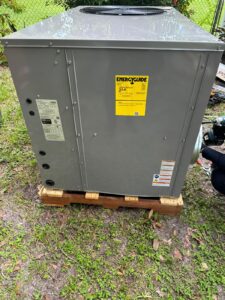
Types of Furnaces and Their Typical AFUE Ratings
When selecting a furnace for your home, understanding the different types and their respective Annual Fuel Utilization Efficiency ratings is crucial. AFUE ratings provide a key indicator of how efficiently a furnace converts fuel into heat. Here’s a look at the common types of furnaces and their typical AFUE ratings:
1. Conventional Natural Draft Furnaces:
- AFUE Range: Typically between 55% and 70%.
- Characteristics: These are older models, often found in homes built before the 1980s. They use a natural draft created by a chimney to expel combustion gases and tend to be less efficient due to significant heat loss.
2. Mid-Efficiency Furnaces:
- AFUE Range: Generally between 80% and 83%.
- Characteristics: These furnaces use exhaust fans to control the flow of combustion air and flue gases more precisely. They often feature electronic ignition (as opposed to a standing pilot light), which improves efficiency. These models are a common choice for replacements in existing homes.
3. High-Efficiency Condensing Furnaces:
- AFUE Range: Typically 90% to 98.5%.
- Characteristics: These are the most efficient models available. They achieve high efficiency by condensing the water vapor in the exhaust gases and recovering its latent heat, which would otherwise be wasted. Due to their high efficiency, they can have lower fuel costs over time but may have higher initial installation costs. These furnaces are particularly suitable for colder climates where the furnace operates for extended periods.
4. Electric Furnaces:
- AFUE Range: Often close to 100%.
- Characteristics: Electric furnaces convert nearly all the energy they use into heat, but this doesn’t necessarily mean they are the most cost-effective option. Electricity can be a more expensive heating fuel compared to gas or oil. However, they can be a good choice in areas where electricity costs are low or where other fuel options are unavailable.
5. Oil Furnaces:
- AFUE Range: Typically between 80% and 90%.
- Characteristics: These are less common than gas furnaces and are typically used where natural gas is not available. Modern oil furnaces are significantly more efficient than older models but can be more expensive to operate due to the higher cost of oil compared to natural gas.
6. Modulating Furnaces:
- AFUE Range: Varies, but many are high-efficiency models.
- Characteristics: Modulating furnaces can continuously adjust their heat output to precisely match the heating demand of your home. This results in higher efficiency and better comfort control. They are often equipped with variable-speed blowers, further enhancing efficiency and comfort.
7. Multi-Stage Furnaces:
- AFUE Range: Often high-efficiency models.
- Characteristics: These furnaces can operate at different levels, typically at a high and a low stage. This allows them to provide more efficient heating on milder days (using the low stage) and more powerful heating in extreme cold (using the high stage).
Factors Affecting AFUE
The Annual Fuel Utilization Efficiency (AFUE) rating is a crucial measure of a heating system’s efficiency, indicating the percentage of fuel converted into heat. However, several factors can influence a furnace’s AFUE rating, affecting its overall efficiency. Understanding these factors is key for homeowners looking to optimize their heating systems. Here are the primary factors affecting Annual Fuel Utilization Efficiency:
1. Age of the Heating System:
- Older heating systems generally have lower AFUE ratings compared to newer models due to advancements in technology. As a furnace age, its efficiency can also decline, especially if it hasn’t been regularly maintained.
2. Maintenance and Upkeep:
- Regular maintenance is crucial for maintaining a furnace’s efficiency. Neglected systems can suffer from issues like clogged filters, dirty burners, or improper burner operation, all of which can reduce efficiency.
3. Quality of Installation:
- The efficiency of a heating system is significantly impacted by how well it is installed. Poor installation can lead to heat loss, inadequate air distribution, and overall reduced efficiency, regardless of the AFUE rating.
4. Type of Fuel Used:
- The type of fuel a furnace uses can affect its efficiency. Natural gas furnaces tend to have higher AFUE ratings compared to oil furnaces. Electric furnaces often have very high Annual Fuel Utilization Efficiency ratings but can be expensive to operate depending on local electricity prices.
5. Furnace Size Relative to Home Size:
- A furnace that is too large or too small for the space it is heating will operate less efficiently. An oversized furnace will cycle on and off more frequently, reducing its efficiency. Conversely, an undersized furnace will have to work harder to heat the space, also reducing efficiency.
6. Ventilation and Ductwork:
- The condition of a home’s ductwork can significantly impact furnace efficiency. Leaky or poorly insulated ducts can result in significant heat loss, reducing the overall efficiency of the heating system.
7. Thermostat Settings:
- The way a homeowner uses their thermostat can affect the efficiency of their heating system. Constantly changing settings or setting the thermostat very high can lead to less efficient operation.
8. Home Insulation and Sealing:
- The overall energy efficiency of a home, including insulation and sealing against drafts, plays a significant role in heating efficiency. Better-insulated homes retain heat more effectively, allowing the furnace to operate more efficiently.
9. External Weather Conditions:
- In extremely cold climates, a furnace has to work harder to maintain indoor temperatures, which can affect its efficiency. Conversely, in milder climates, a furnace may operate more efficiently due to less demand.
10. Technological Features:
- Modern furnaces often come with advanced features like variable speed blowers and modulating gas valves, which can significantly improve efficiency. These features allow the furnace to adjust its output more precisely to the needs of the home.
AFUE and Rebates
In some regions, purchasing a high-efficiency furnace can qualify you for rebates and incentives. These programs are designed to encourage homeowners to choose more efficient appliances.
Common Misconceptions About AFUE
1. Higher AFUE Equals Significant Cost Savings:
- While it’s true that a higher Annual Fuel Utilization Efficiency rating indicates a more efficient furnace, the actual cost savings can vary. The savings depend on factors like the climate, the size and insulation of the home, the type of fuel used, and energy prices. In some cases, the additional cost of a high-efficiency furnace may not be offset by the energy savings.
2. AFUE Is the Only Factor to Consider for Efficiency:
- AFUE measures the efficiency of converting fuel to heat, but it doesn’t account for other factors like heat loss through ductwork or the overall heating needs of the home. A comprehensive view of home heating efficiency should include considerations like home insulation, duct sealing, and proper furnace sizing.
3. An 80% AFUE Furnace Loses 20% of Heat Through the Chimney:
- This is a simplification. While an 80% AFUE furnace converts 80% of the fuel to heat, the remaining 20% isn’t necessarily lost solely through the chimney. It can also be lost due to incomplete combustion, heat loss from the furnace casing, and other inefficiencies in the heating process.
4. Electric Furnaces Are Always the Most Efficient:
- Electric furnaces often have near 100% Annual Fuel Utilization Efficiency ratings because almost all the electricity they use is converted into heat. However, this doesn’t necessarily make them the most cost-effective option. Electricity is often more expensive than gas or oil, so operating costs can be higher despite the high AFUE rating.
5. AFUE Ratings Are Constant Over Time:
- The AFUE rating of a furnace is determined when it’s new. Over time, the efficiency of a furnace can decrease if it’s not properly maintained. Regular maintenance is essential to keep a furnace operating close to its original AFUE rating.
6. Upgrading to a High AFUE Furnace Always Reduces Carbon Footprint:
- While high-efficiency furnaces generally produce fewer emissions, the overall impact on your carbon footprint depends on the source of your electricity or fuel. For example, if your electricity comes from coal-fired power plants, an electric furnace might not be the greenest choice.
7. All High-Efficiency Furnaces Are Condensing Furnaces:
- Most high-efficiency furnaces are condensing furnaces, but not all. Condensing furnaces typically have AFUE ratings of 90% or higher because they can convert exhaust gas into additional heat. However, there are non-condensing furnaces with AFUE ratings in the 80%-89% range that are still considered high-efficiency.
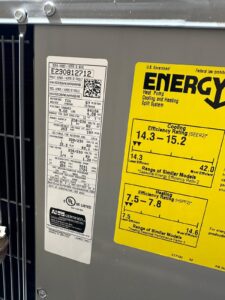
Maximizing Home Comfort and Efficiency: The AC Therapist’s Take on AFUE in HVAC Systems
In conclusion, understanding AFUE – Annual Fuel Utilization Efficiency – is crucial for any homeowner looking to enhance their home’s heating efficiency and comfort. As we’ve explored in this blog, AFUE is a key indicator of how well your furnace or boiler converts fuel into heat, directly impacting your energy bills, environmental footprint, and overall home comfort.
However, it’s important to remember that while Annual Fuel Utilization Efficiency is a valuable metric, it’s not the only factor to consider when assessing your HVAC system’s efficiency. The age of your system, maintenance practices, installation quality, and your home’s insulation all play pivotal roles in determining overall heating efficiency.
At The AC Therapist, we understand the importance of a comprehensive approach to home heating. We believe in not just looking at the AFUE rating but also considering the holistic performance of your HVAC system. Our expertise in air conditioning services, including repair, installation, and maintenance, ensures that your system operates at peak efficiency, providing you with comfort and savings regardless of the season.
Remember, the goal is not just to choose a furnace with a high AFUE rating but to create a balanced, efficient, and comfortable home environment. With the right knowledge and the expert services of The AC Therapist, you can achieve this balance, ensuring your home remains a cozy haven for you and your family. Whether you’re looking to upgrade your system, require regular maintenance, or need tailored advice on heating efficiency, The AC Therapist is here to guide you every step of the way.

